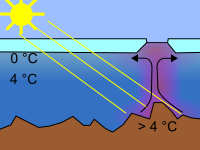Steam hole
Steam holes are star-shaped holes from a few centimeters to meters in size in the ice cover of shallow, stagnant water, which are formed there due to convection processes in the water.
In order for steam holes to form, a clear, transparent ice cover is required, through which sunlight can penetrate to the bottom of the lake and warm it up. If the temperature of the water exceeds 4 ° C, an unstable situation arises: Directly under the ice, water is cooled to 4 ° C, which tends downwards due to its higher density; on the lake bed, on the other hand, warm water pushes upwards. A convection forms. In places where a lot of warm water pushes upwards, this melts away the ice cover and creates an ice hole. The typical spikes are caused by the fact that in the convection the warm water not only rises selectively and warm water also rises in the direction of the jets, even if not as much at once as in the middle of the ice hole.
For this phenomenon to occur, temperatures above 0 ° C require a sudden cold snap, so that on the one hand the lake is still warm enough so that the sun can warm its bottom to over 4 ° C, but on the other hand a closed ice cover can form . In addition, there must be no snowfall, as this would otherwise make the ice surface opaque. Therefore this phenomenon occurs quite rarely, and when it does occur, for lack of better knowledge, the wildest speculations about the causes arise, e.g. B. alleged meteorite impacts.
